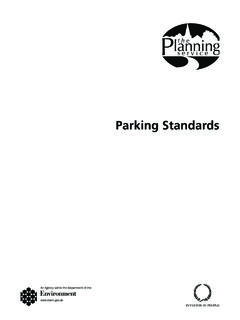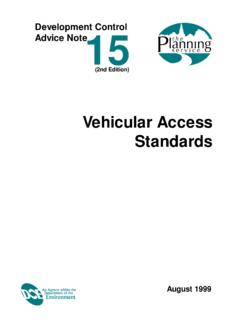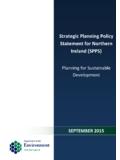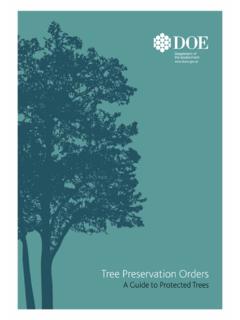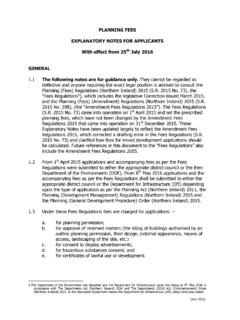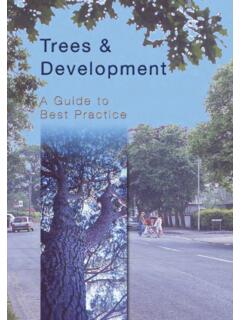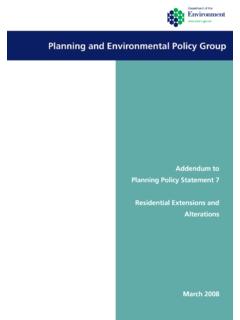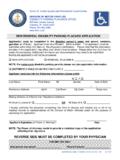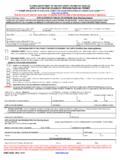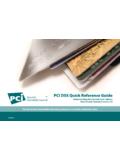Transcription of Parking Standards - Planning Portal
1 Parking Standards Contents Page No. Introduction 1. General Considerations 1-2. Cycle Parking 2-3. Motorcycle Parking 3. Interpretation 3. Parking Standards - Non-Residential Development 4-12. Annexes Annex A Residential Parking Standards 13-15. Annex B Cycle Parking Design Details 16-21 Introduction 1. This document sets out the Parking Standards that the Department will have regard to in assessing proposals for new development. It includes Parking Standards for residential development previously published in Creating Places Achieving Quality in Residential Developments'.
2 2. The Standards comprise Supplementary Planning Guidance and should be read in conjunction with the relevant policies contained in Planning Policy Statements or the development plan. 3. The principle objective of the Parking Standards is to ensure that, in assessing development proposals, appropriate consideration is given to the accommodation of vehicles attracted to the site within the context of wider government policy aimed at promoting modal shift to more sustainable forms of transport. 4. The precise amount of car Parking will be determined according to the speci c characteristics of the development and its location having regard to these Standards or any reduction provided for in an area of Parking restraint designated in a development plan.
3 Proposals should not prejudice road safety or signi cantly inconvenience the ow of traf c. 5. Developers are advised to consult the relevant development plans to ascertain whether speci c Parking limitations apply to their proposed development location. General Considerations 6. In assessing the Parking provision in association with development the Department will normally expect developers to provide an access to the site in accordance with the current standards1. Where appropriate, developers will be required to demonstrate there is adequate provision of space within the site, for Parking , manoeuvring, loading and unloading to ful l the operational requirements of the proposed development.
4 7. Where developments incorporate more than one land use which are functioning simultaneously, a warehouse containing a large of ce or a public house containing a restaurant, the combined gures applicable to both uses will apply. Conversely, in multi-purpose development where it can be shown that separate uses operate at different times of the day greater exibility will be applied. 8. Floor areas quoted in the guidelines relate to Gross Floor Area unless otherwise stated. 1. Development Control Advice Note 15, 1999 2nd Edition Vehicular Access Standards . 1. 9. The term one space' used in the Standards refers to standing area only and the recommended minimum dimensions for a car space are metres by metres.
5 The term commercial vehicle space' used in the Standards refers to the standing area required for the general type of commercial vehicle which would normally serve the particular development. 10. The following are standard space requirements of some typical vehicles. These may be used as basic minimum reference values but different layouts such as parallel, herringbone and in-line, have slightly different overall space requirements and detailed layout of Parking spaces will be site speci c. Car metres x metres Light Vans metres x metres Rigid Vehicles metres x metres Articulated Vehicles metres x metres Coaches (60 seats) metres x metres These dimensions refer to standing space only and do not take account of access, manoeuvring space or space required for loading/unloading.
6 11. Operational Parking space for commercial and service vehicles will depend on the type attracted to a development and should provide for manoeuvring space to enable vehicles to exit the site in forward gear. 12. Best practice on the number, size and layout of Parking spaces reserved for people with disabilities and general guidance on the provision of appropriate related facilities is set out in the Department's guide Access for All'. 13. The Department will, on request or as necessary, provide advice on the Parking requirement for developments not covered by these Standards taking into account the number and size of vehicles likely to use the proposed development at any one time and wider Government policy on transportation.
7 Cycle Parking 14. The promotion of cycling as a travel opportunity is part of the drive to promote alternatives to the private car and encourage more sustainable means of travel. One step in this process is to improve the provision, safety, convenience and general environment for cycling by ensuring that the needs of cyclists are fully taken into account in the development process. To help promote cycle use the amount of good quality cycle Parking needs to be increased. It is important therefore that secure cycle Parking is provided as an integral part of new development.
8 15. Cycle theft is a major problem and concerns most cyclists. The provision of carefully planned, secure Parking facilities can help to reduce this concern 2. and may also help promote the use of cycle routes. A bene cial effect of providing designated cycle Parking areas may be a reduction in haphazard chaining of bicycles to railings, pipes and lighting columns, thus removing clutter and inconvenience to pedestrians and frontages. 16. Where the Department has determined that secure cycle Parking facilities should be provided the precise amount will be assessed against the published Standards .
9 Full secure, weather protected Parking will normally be required for employee cycle Parking . Weather protection will also be required for visitor Parking where space for ten or more cycles is provided or in cases where medium to long-term cycle Parking is required, for instance at public transport interchanges. Motorcycle Parking 17. Parking provision for motorcycles will be assessed on demand. The number of motorcycles in use in Northern Ireland is approximately 2% of the total number of cars. Where provided or required the location of motorcycle bays within a development should take account of the requirements of users and recognise that they are vulnerable in tight or enclosed space.
10 18. Motorcycle theft is also a problem that concerns most riders. The provision of carefully planned, secure Parking facilities which provide for natural surveillance can help to reduce this concern. Additional security can be afforded through the provision of security bollards or inground motorcycle clamps to which motorcycles can be chained. Purpose built security systems are also available which clamp the front wheel of a motorcycle and include combined storage facilities for clothes and accessories. Interpretation 19. For the purpose of interpreting the attached Standards .
